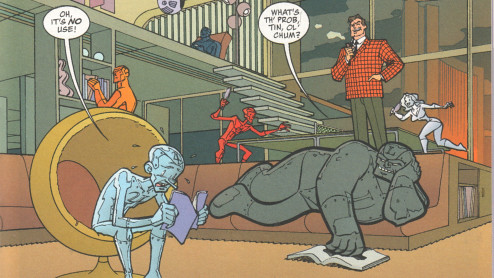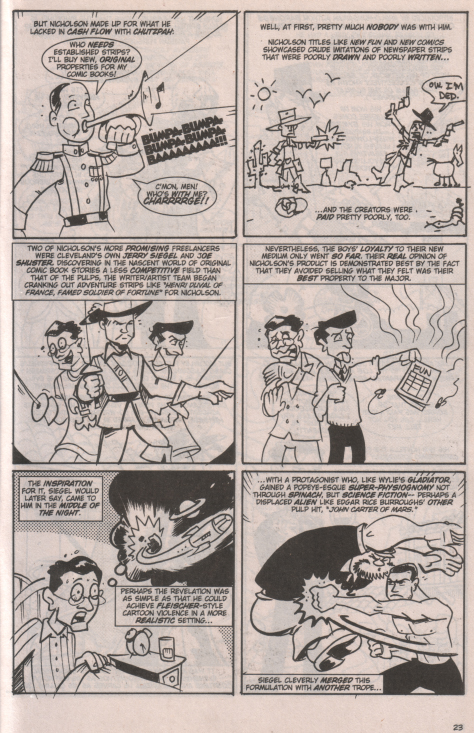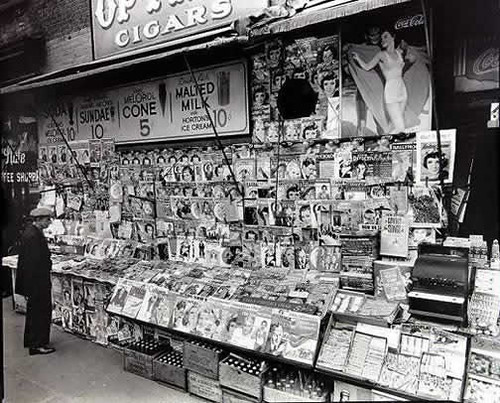The proud Kuleeah was furious because Tarzan had made sport of her. Now she dashed toward him, determined to redeem her pride with his blood. She aimed a murderous blow at the head of unarmed ape-man. Again, Tarzan dodged, whirled, seized her, and lifted her high above his head. There he held her, kicking and squirming, while her comrades hurled gleeful taunts.
Though they laughed at Kuleeah's plight, they were impressed by the mighty Tarzan. “He can be my husband, though he conquer me and rule my hut,” cried one. This was heresy among the Amazons, who prided themselves on their dominance over men.
“I'll take him,” shouted another.
“No, he's mine,” insisted a third.
Soon, the tribe was in turmoil. As the warrior women fought amongst themselves, Tarzan set Kuleeah down. She ran away to get her bow and arrows. If she could not have him, no other would.
Then, suddenly, into this wild confusion burst a pack of hungry lions.
Although it does start in media res, this passage appears to be a pretty complete section of a narrative. Even from this excerpt, we can discern a lot about the characters and setting, and we can certainly follow the action. Is this a bit of a Burroughs book, or some fanfic, or what? Well, take a look at it in its original:
 Click to embiggify
Click to embiggifyI ran across this Sunday strip at the ASIFA-Hollywood Animation Archive, which also has a wealth of comics and cartooning stuff.
I forget why I stumbled over it, but looking at this page immediately got me to thinking: there is no one, I think, who would exclude this page from a collection of comics, or comic strips, or sequential art, or graphic literature, or whatever phrase we want to use for all that funnybook stuff we like so much.
And yet, if we really look at the strip, there's no real fusion of word and image to make meaning or create communication. The text, as demonstrated above, can easily stand on its own and carry the entire narrative weight of the piece. The art, as exquisite as it is, really doesn't help to tell the story; it contains nothing new, no information that isn't already expressed by the text. The drawings certainly couldn't stand on their own and give us anywhere near the narrative detail that the text does. (For example, is there anything in panel four to indicate that the Amazons are "hurling gleeful taunts"?) To paraphrase Steve Lieber, the pictures may illustrate the story, but they aren't the story.
This seems to contradict what we expect from comics, that magical conjunction of words and pictures that creates something new, something that is neither merely prose nor art, but, well, comics.
We mist be missing something, but damned if I know what it is.
Maybe definition isn't that important after all.
This makes a dozen dozen posts on this blog: 144 entries in 915 days, about one a week. I know, that's pretty gross. I was looking for a significant milestone to quit on, and I thought this might be the one. But I don't think so now; there may be a few more things I want to say before that.
I forget why I stumbled over it, but looking at this page immediately got me to thinking: there is no one, I think, who would exclude this page from a collection of comics, or comic strips, or sequential art, or graphic literature, or whatever phrase we want to use for all that funnybook stuff we like so much.
And yet, if we really look at the strip, there's no real fusion of word and image to make meaning or create communication. The text, as demonstrated above, can easily stand on its own and carry the entire narrative weight of the piece. The art, as exquisite as it is, really doesn't help to tell the story; it contains nothing new, no information that isn't already expressed by the text. The drawings certainly couldn't stand on their own and give us anywhere near the narrative detail that the text does. (For example, is there anything in panel four to indicate that the Amazons are "hurling gleeful taunts"?) To paraphrase Steve Lieber, the pictures may illustrate the story, but they aren't the story.
This seems to contradict what we expect from comics, that magical conjunction of words and pictures that creates something new, something that is neither merely prose nor art, but, well, comics.
We mist be missing something, but damned if I know what it is.
Maybe definition isn't that important after all.
This makes a dozen dozen posts on this blog: 144 entries in 915 days, about one a week. I know, that's pretty gross. I was looking for a significant milestone to quit on, and I thought this might be the one. But I don't think so now; there may be a few more things I want to say before that.








